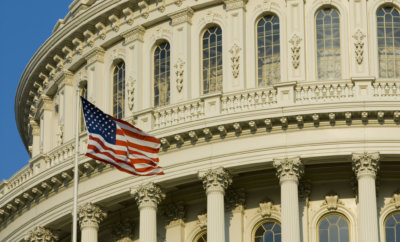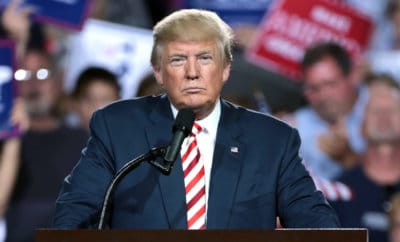Education
New York Asians Feel Overlooked in the City’s ‘Huge Blind Spot’
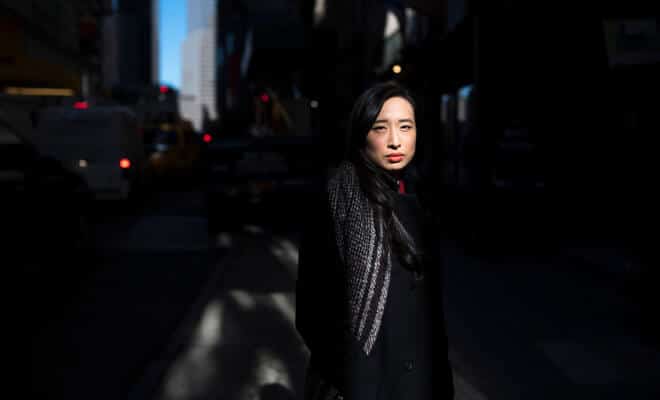
Assemblywoman Yuh-Line Niou, a Democrat who represents Chinatown and Lower Manhattan, in New York, Feb. 18, 2016.
Photo: Karsten Moran/The New York Times
Asian-American community leaders say that in New York, they are the overlooked minority, taken for granted in the city’s calculus of political power.
When Mayor Bill de Blasio proposed earlier this month to change the way students are admitted to the city’s most elite public high schools, he was surrounded by dozens of enthusiastic students, union leaders and elected officials, amid signs proclaiming “All Kids Deserve a Chance.”
Noticeably absent were representatives from one group that would be heavily affected by the change: Asian-Americans, whose children dominate those schools.
“This cliché of, ‘If you’re not at the table, you’re on the menu’ really felt like it rang true,” said U.S. Rep. Grace Meng, D-Queens and graduate of one of the schools, Stuyvesant High School, who was not invited to the event. “I don’t think with any other community if there was such a large impact or sweeping change, they would not have been consulted or brought into the discussions.”
Asian-American community leaders say that in New York, far from being the “model minority” — a term many view as disparaging and inaccurate — they are the overlooked minority, taken for granted in the city’s calculus of political power.
It does not seem to matter, Asian-American officeholders and activists say, that all five Asian-American elected officials at the city, state and federal levels are Democrats, like de Blasio and Gov. Andrew Cuomo. Nor does it matter that Asian-Americans of all backgrounds, including East and South Asians, now make up almost 15 percent of the city’s population, with the total number up by more than half since 2000. Or that the number of Chinese and Korean registered voters has doubled over the same period, according to the Center for Urban Research at the CUNY Graduate Center.
“It’s not just one thing, and it’s not just one time,” said Assemblywoman Yuh-Line Niou, a Democrat who represents Chinatown and lower Manhattan. “It shows a huge blind spot for Asian-American communities as a whole.”
The list of grievances is long. When de Blasio ran for mayor in 2013, he pledged to designate the Lunar New Year a school holiday. But he did not deliver until 2015 — after he had already added two Muslim holy days to the calendar and was facing the potential political embarrassment of having the state Legislature make good on his promise.
“We had been pressing him for so long, then all of a sudden he changed his mind, because the state wanted to do something,” said City Councilman Peter Koo, who represents Queens neighborhoods including Flushing and Whitestone.
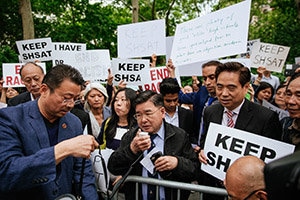
City Councilman Peter Koo addresses activists gathered to rally in protest of the city’s plan to revamp admissions to the city’s specialized high schools, in New York, June 5, 2018. Photo Credit: Kevin Hagen/The New York Times
In 2016, thousands of Asian-Americans protested City Hall’s handling of the case involving Peter Liang, a rookie Chinese-American police officer who was convicted of manslaughter in the death of an unarmed black man, Akai Gurley, who was hit by a ricocheting bullet fired from the officer’s gun. Liang, they argued, was a scapegoat to placate a black community angered by the death of Eric Garner and other fatalities where the officers involved, most of them white, had gone unpunished.
More recently, de Blasio targeted electric bicycles, citing safety concerns and the complaints of residents who say they are dangerous. Yet e-bikes are crucial to the livelihood of immigrant delivery workers, many of whom live below the poverty line.
“We’ve been advocating to get these bikes legalized, and suddenly the mayor decided to say, ‘Oh, we’re going to crack down even more?’” said City Councilwoman Margaret Chin, who represents lower Manhattan. “Hey, did you talk to us?”
But it was de Blasio’s proposal to tackle the vexing issue of segregation at the specialized high schools that galvanized Asian reaction. The eight schools, which have a single test for admissions, have a disproportionate number of Asian students, and few black and Latino ones.
De Blasio has proposed throwing out the test and instead admitting students based on their class rank and state test scores, which would increase the numbers of black and Latino students significantly. Because the number of seats at the school are limited, that would necessarily mean fewer Asian students would get in. Changing the admissions method would require an act of the Legislature for the three long-established specialized schools, and perhaps for all of them.
But in announcing the plan de Blasio did not mention the schools’ importance to Asian-Americans. Despite stereotypes about their success, Asian-Americans are the poorest immigrant group in the city, noted Joseph P. Viteritti, a professor of public policy at Hunter College, and many view the schools as a ladder to the middle class, and the test as the fairest way to determine admission.
A report released Thursday by the Asian-American Federation, a network of community service groups, found that 9 in 10 Asian households in poverty lack affordable housing, and one-quarter of those eligible to work did not have health insurance.
Richard A. Carranza, the schools chancellor, intensified matters when he said in a television interview, “I just don’t buy into the narrative that any one ethnic group owns admissions to these schools.”
John C. Liu, a former councilman and city comptroller whose mayoral ambitions were derailed by financial improprieties, called Carranza’s remarks “the most offensive and irritating comments that Asian-Americans have heard in quite some time.”
Liu, along with Chin is a graduate of the Bronx High School of Science, another of the elite high schools.
Carranza, asked whether he could have displayed more empathy to Asian-American families deeply invested in the current system, did not back off his comments.
“If you choose to be offended as an Asian resident of New York City, that’s a choice you make,” he said. “If you choose to not be offended, that’s a choice you make. But the statement is true: No one owns it. The City of New York, taxpayers, own the public school system of New York City.”
Asked about the criticisms, Eric Phillips, de Blasio’s press secretary, seemed more conciliatory: “When leaders in a community tell us we need to do more to engage them, we take it as a serious sign we have to do more, and do better,” he said in a statement. “While we aren’t going to shy away from doing what we believe is right, every community has a right to be heard and engaged — and it’s our job to make sure this community is a part in that process.”
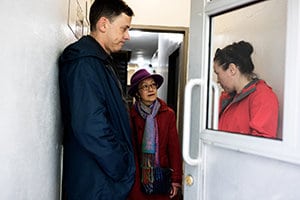
City Councilwoman Margaret Chin, center, who represents Lower Manhattan, in New York, May 17, 2018. Photo Credit: Demetrius Freeman/The New York Times
A central question in the debate is where Asians fall in the worldview of the city’s political establishment. Eric Adams, the Brooklyn borough president, had initially backed de Blasio’s proposal. But after facing a backlash from Asian community leaders, and the prospect that some donors would cancel future fundraisers, Adams moderated his position and expressed reservations.
“Some progressives seem to be pushing the narrative that Asians are not minorities, immigrants and people of color,” said Assemblyman Ron Kim, D-Queens. And that is “even worse when done in the name of reform and social justice,” he added, and may drive some Asian-Americans to embrace more conservative and Republican candidates.
De Blasio’s proposal coincided with new revelations that Harvard University had used intangible measures like personality traits to lower Asian applicants’ ratings, in an effort to limit their numbers at the college.
Lost in the rhetoric, Kim and other elected leaders said, is the fact that Asian-Americans are hardly monolithic on issues of race and education, as evidenced by their wide range of opinions over affirmative action.
Reshma Saujani, who is of Indian descent, was deputy public advocate under de Blasio and is the founder of Girls Who Code, which aims to attract girls to tech, including black and Hispanic students. She said she supported the mayor’s initiative. At her own summer programs, “I turn away girls who look like me every single day,” she said.
But Saujani said that “as a South Asian activist, I know that we as a community have not achieved our political voice in New York, so it doesn’t shock me that people feel that we weren’t considered when they were drafting the policy.”
Jo-Ann Yoo, executive director of the Asian American Federation, said, “As much as we understand and applaud the mayor’s efforts to diversify the specialized high schools, there is tremendous anger among parents around the lack of engagement prior to the announcement.”
In their view, rather than making Asian-Americans part of the solution to the racial imbalance at the specialized schools, de Blasio targeted them as the problem, making the prospect of selling them on the change that much more difficult.
“He ran for office, in part, by saying he would open the pathways for political engagement and community engagement” in a way that former Mayor Michael Bloomberg did not, said Basil A. Smikle Jr., a former executive director of the New York state Democratic Party. “But sometimes the process is just as important as the outcome, and the process unfortunately tarnished the potential outcome of this policy.”
© 2018 New York Times News Service

